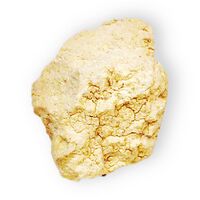Chemistry:Hectorite
| Hectorite | |
|---|---|
 Hectorite from California | |
| General | |
| Category | Phyllosilicates Smectite |
| Formula (repeating unit) | Na0.3(Mg,Li)3Si4O10(OH)2 (empirical: Na3(Mg,Li)30Si40O100(OH)20) |
| Strunz classification | 9.EC.45 |
| Crystal system | Monoclinic |
| Crystal class | Prismatic (2/m) (same H-M symbol) |
| Space group | C2/m |
| Unit cell | a = 5.25 Å, b = 9.18 Å c = 16 Å; β = 99°; Z = 2 |
| Identification | |
| Color | White, cream, pale brown, mottled |
| Crystal habit | Thin laths and aggregates |
| Cleavage | [001] Perfect |
| Fracture | Uneven |
| Mohs scale hardness | 1–2 |
| |re|er}} | Earthy to waxy |
| Streak | White |
| Diaphaneity | Translucent to opaque |
| Specific gravity | 2–3 |
| Optical properties | Biaxial (−) – 2V small |
| Refractive index | nα = 1.490 nβ = 1.500 nγ = 1.520 |
| Birefringence | δ = 0.030 |
| References | [1][2][3] |
Hectorite is a rare soft, greasy, white clay mineral with a chemical formula of Na
0.3(Mg,Li)
3Si
4O
10(OH)
2.[1]
Hectorite was first described in 1941 and named for an occurrence in the United States near Hector (in San Bernardino County, California,[3] 30 miles east of Barstow.) Hectorite occurs with bentonite as an alteration product of clinoptilolite from volcanic ash and tuff with a high glass content.[1] Hectorite is also found in the beige/brown clay ghassoul, mined in the Atlas Mountains in Morocco.[5] A large deposit of hectorite is also found at the Thacker Pass lithium deposit, located within the McDermitt Caldera in Nevada. The Thacker Pass lithium deposit could be a significant source of lithium.[6]
Despite its rarity, it is economically viable as the Hector mine sits over a large deposit of the mineral. Hectorite is mostly used in making cosmetics, but has uses in chemical and other industrial applications, and is a mineral source for refined lithium metal.[7]
See also
- Classification of minerals
- List of minerals
- Saponite
References
- ↑ Jump up to: 1.0 1.1 1.2 "Hectorite". Handbook of mineralogy. Tucson, Ariz.: Mineral Data Publishing. 1995. ISBN 9780962209734. OCLC 20759166. http://rruff.info/doclib/hom/hectorite.pdf.
- ↑ "Hectorite Mineral Data". http://webmineral.com/data/Hectorite.shtml.
- ↑ Jump up to: 3.0 3.1 Jololyn R (2007). "Hectorite: Mineral information, data and localities.". https://www.mindat.org/min-1841.html.
- ↑ Warr, L.N. (2021). "IMA–CNMNC approved mineral symbols". Mineralogical Magazine 85 (3): 291–320. doi:10.1180/mgm.2021.43. Bibcode: 2021MinM...85..291W.
- ↑ "Mineralogical and Physicochemical Investigation of Mg-Smectite from Jbel Ghassoul, Morocco". Clays and Clay Minerals 57 (2): 264–270. 2009. doi:10.1346/CCMN.2009.0570212. Bibcode: 2009CCM....57..264B.
- ↑ Bradley, Dwight C.; Stillings, Lisa L.; Jaskula, Brian W.; Munk, LeeAnn; McCauley, Andrew D. (2017). Lithium, Chapter K of Critical Mineral Resources of the United States—Economic and Environmental Geology and Prospects for Future Supply (Report). United States Geological Survey. https://pubs.usgs.gov/pp/1802/k/pp1802k.pdf.
- ↑ "Between a rock and a salt lake". Industrial Minerals 477: 58–69. 2007.
 |

